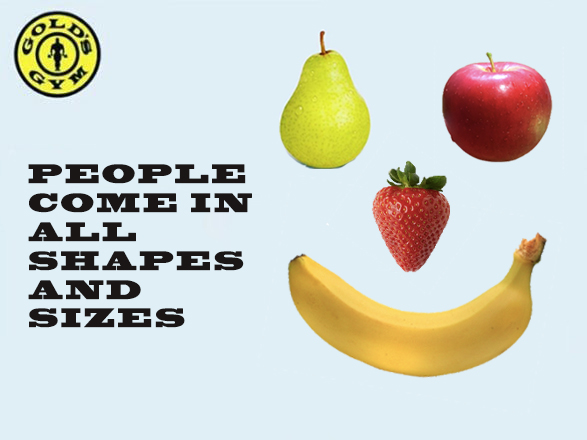
Original Advertisement
This original ad, released by Gold’s Gym in August 2016, reads “This is no shape for a girl” next to an image of a pear. The ad faced backlash for its body-shaming premise as an advertisement meant to persuade women to work out at their gym. The ad makes use of existing terminology such as “pear-shaped,” which is often used by women in neutral, self-describing ways, but then adds deeply negative connotation to the phrase. The ad attempts to employ humor and wit, featuring an image of a pear to represent a female body rather than an actual person. This decontexualizes and reduces a natural body shape that millions have into a physical representation used for a joke. It disembodies women to make direct body-shaming more palatable to the consumers’ eyes. The pear is pictured alone in an effort to cast it as an anomaly or outcast in comparison to other body shapes. This makes women more susceptible to feeling an emotional identification and resulting response, whether it shames them or encourages them to buy a gym membership. These reactions are not mutually exclusive. The text itself takes an authoritarian and decisive tone. It reads as if it is the final say on what is or is not an appropriate physique. It implies that anyone who identifies with being a “girl” should exist within narrow parameters of body size and shape. It negates the idea of women existing in any other form, and the usage of “girl” feels patronizing. The ad reads like an antiquated ad targeting housewives in the 1950s. A lingerie ad from the company Warner’s originally did create an advertisement in the 1970s with the same text and image of a pear. The Gold’s Gym ad doesn’t even attempt to disguise archaic and uninformed attitudes towards women.

Jammed Advertisement
My jammed version of the advertisement is what I would hope gym advertisements could potentially look like, if gyms didn’t need to push membership and profit through body-shaming tactics. My ad is an alternative to those techniques. Culture jamming, for media activist Kalle Lasn, attempts to “reverse or subvert their meaning, thus reclaiming them” (Lasn qtd in Warner p. 21) Although the message of my new ad is entirely opposite of the original, I tried to use the original elements. The fruit, used to represent an “undesirable” body shape in the original ad, is shown again alongside other fruits, representing other body shapes. Although I could have potentially featured bodies of actual women instead of fruits, a “subvertisement” often “mimics the look and feel of the target ad” and can rely on the same tactics or branding to get a message across. Utilizing the same fruit/body shapes logic that the original ad uses strengthens the new ad’s criticisms (Lasn qtd in Warner p. 21). The original ad’s singling out of the pear as an image and stand-in for a certain body shape is part of what makes it problematic. There is an isolation here that works to shame women who may identify with that body shape, to frame them as outliers or anomalies. By bringing other fruits into the image, I attempt to reverse that “singling out” and show other fruits/shapes that are all different. There is a more collective, inclusive sense brought to the ad’s overall feeling, and the fruits forming a smiley face embodies a positive spin on the original ad. The text, “People come in all shapes and sizes” is a clear opposition to the original text, using the same matter-of-fact tone. I used “people” instead of “girl” as the subject to reverse the targeted aspect of the original ad and retained the word “shape” to connect it to the original text.
Warner, J. (2007). Political Culture Jamming: The Dissident Humor of “The Daily Show With Jon Stewart”. Popular Communication, 5(1), 17-36. doi:10.1080/15405700709336783